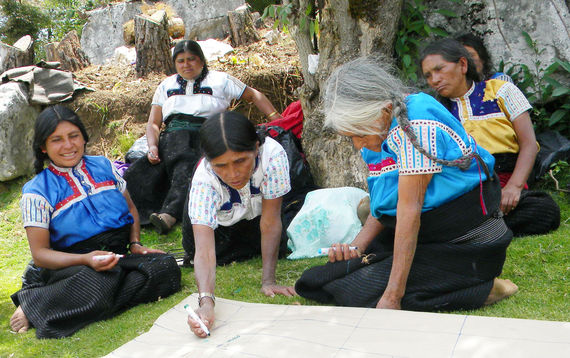What will it take to achieve the bold, 2030 global agenda – the Sustainable Development Goals (SDGs) – adopted one year ago?
A growing movement of organizations is pushing one key policy change that might seem obvious, yet continues to be missing in the countries that need it most: that policy change is putting a fair share of public resources and decision-making power into the hands of local communities – and is critical to achieving the SDGs.
Community planning in Chiapas, Mexico. Photo: The Hunger Project
Most of the basic issues of life must get addressed at the community level: clean water, safe sanitation, public safety, primary education and health care, employment opportunities and more. National policies can set standards and mobilize resources, but if there is nobody at the local level accountable to make it happen – it won't happen. If the sewers back up, you really shouldn't have to go to the national bureaucracy to get it fixed. Yet this situation is widespread, and it results in a paralyzing sense of powerlessness and resignation.
Women and men have a fundamental right to be the authors of their own development, and that right must start in the communities where they live and work. SDG 16 calls for participatory decision making and effective, accountable institutions at all levels. This must start at the community level. Yet, these institutions are weakest in the areas where they are needed the most.
In the US, for example, 24% of public resources are in the hands of local government. But in many low-income countries, it is less than 2%. If you were elected to a local council in one of these countries, you might not receive any training or clear guidance on how to get things done. And, there might not be any organized citizen groups able to demand accountability.
The good news is that there are proven, step-by-step methodologies for transforming this situation, and unleashing the creativity and responsibility of local people to take charge of their futures. Korea's "Saemaul Undong" (New Villages) program in the 1970s, for example, is credited with transforming Korea from a least-developed country to a global powerhouse in less than a generation. Countries as diverse as Afghanistan and Brazil have implemented nationwide programs based on strengthening local communities – both local government and grassroots civil society – to successfully meet pressing basic needs. There are growing examples of successful national programs in Vietnam, Indonesia, Bolivia and elsewhere.
One year ago, on the day the world adopted the SDGs, 18 international organizations launched the "Movement for Community-Led Development" to expand this approach to every country where this type of development is needed. Today, the movement has grown to 38 organizations with a presence on the ground in 90 countries.
Our theory of change for making community-led development available everywhere is straight-forward:
- Community Organizers: Communities need both resources and skills. Successful community-led development programs provide skilled facilitators who are able to transform the prevailing mindset of dependency and resignation, build community institutions, and help communities navigate the complexities of budget preparation, project management, transparency and accountability. Our members – and many other civil society organizations – are great reservoirs of this talent and are ready to take action.
- Country Ownership: This capacity-building process is not terribly expensive, but it's not free. Turning it into a nationwide program requires the wholehearted support of host-governments and their development partners. There must be reliable and sufficient public funds for community action, such as block grants, and this requires transparent and accountable procedures.
- Advocates: Securing these national-level policy changes requires sustained, effective advocacy campaigns in-country as well as globally. For example, our movement's national chapter in Malawi has forged a partnership with parliamentarians and with the ministry of local government to support community-led development nationwide.
So, if community-led development is an obvious and successful solution, what's the problem? The problem is that we continue to live in a top-down, patriarchal world of programs in narrow silos, managed in a command-and-control fashion by the "experts." Those of us who are caring citizens – the advocates for child survival, AIDS and malaria campaigns and other vital goals – have inadvertently fed this top-down machinery with earmarked aid budgets that prompt more top-down targeted programs and top-down demands for reporting and accountability.
As Greg Collins, Director of the USAID Resilience Center recently said to me, "We need to learn to do systems thinking in an earmarked world." High priority issues such as nutrition, women's economic empowerment and climate-change resilience simply cannot be achieved through silos but only through integrated strategies at the community-level. USAID has recently funded a community-led resilience program in West Africa that combines funding from seven different earmarked funding streams. Each funding stream is able to deliver on its mandate, within an integrated strategy.
This shift to bottom-up, integrated community-led development is possible and it's happening. We invite individuals and organizations everywhere to join us in ensuring that all women and men have the chance to apply their creativity, responsibility and best efforts to building communities where the vision of the SDGs are fully realized.
To learn more about the Movement for Community-led Development, visit: communityleddev.org
This post is part of a series produced by The Huffington Post to mark the occasion of the one-year anniversary of the adoption of the Sustainable Development Goals (SDGs, or, officially, "Transforming Our World: the 2030 Agenda for Sustainable Development"). The SDGs represent an historic agreement -- a wide-ranging roadmap to sustainability covering 17 goals and 169 targets -- but stakeholders must also be held accountable for their commitments. To see all the posts in the series, visit here.

